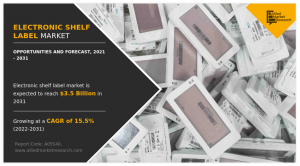Electronic Shelf Label Market Set to Record Exponential Growth by 2031
Electronic Shelf Label Market Expected to Reach $3.5 Billion by 2031 — Allied Market Research
Get a PDF brochure for Industrial Insights and Business Intelligence @ https://www.alliedmarketresearch.com/request-sample/5905
An electronic shelf label (ESL) is a type of dynamic display system used by retailers to display product information in retail stores. This system transmits product information that is updated in the central server using low-power radio frequency (RF) through the gateway. Shelf label is an emerging technology globally, which can help to remove paper labels and automatically change the price tag every week.
In addition, it also removes inconsistencies between cash and shelf register prices and enables flexibility to make immediate price changes. Furthermore, each electronic shelf label (ESL) system has an LCD or E-ink display that shows the price and UPC of the products. These labels eliminate discrepancies in the selling price of products and display reliable pricing to customers. The ESL system has a wide range of applications in various stores such as hypermarkets, supermarkets, non-food retail stores, and specialty stores.
According to the electronic shelf label market analysis, trending automation in the retail industry is the key factor that drives the electronic shelf label market growth of the electronic shelf label industry. Moreover, the necessity for a more cost-efficient and less time-consuming alternative to paper labels and the surge in demand for digital price tags fuel the market growth. In addition, an increase in operational efficiency with real-time product positioning, owing to the utilization of electronic shelf labels, boosts the market growth.
Get Customized Reports with your Requirements: https://www.alliedmarketresearch.com/request-for-customization/5905
However, high installation and infrastructure costs restrain the growth of the electronic shelf label market size. Moreover, low return on investment is also expected to impede the growth of the electronic shelf-label market. Furthermore, the deployment of electronic shelf labels in retail stores allows retailers to update prices on the shelves instantaneously. It also helps them run real-time promotions involving comparison shopping, promotional prices, and promotional information. These features of electronic shelf labels help retailers gain an edge in the competitive retail market, increase sales, and reduce operational costs of the store.
The major companies profiled in the report include E Ink Holdings Inc., Diebold Nixdorf, Incorporated, Samsung Electro-Mechanics, Pricer AB, Displaydata Limited, Panasonic Corporation, NCR Corporation, M2Communication, SES-imagotag, CLEARink Displays Inc., and SoluM Co., Ltd.
KEY FINDINGS OF THE STUDY
- In 2021, the LCD segment was the major revenue contributor to the electronic shelf label industry and is projected to grow at a notable CAGR of 14.55% during the forecast period.
- The displays and microprocessors segments together accounted for around 51.3% of the electronic shelf label market trends in 2021.
- The specialty stores segment is projected to grow at a CAGR of 17.26% during the forecast period.
- Europe contributed to the major electronic shelf label market share, accounting for more than 32.2% share in 2021.
Key players profiled in the report include E Ink Holdings Inc., Diebold Nixdorf, Incorporated, Samsung Electro-Mechanics, Pricer AB, Displaydata Limited, Panasonic Corporation, NCR Corporation, M2Communication, SES-imagotag, CLEARink Displays Inc. and SoluM Co. Ltd. Market players have adopted various strategies, such as product launch, collaboration& partnership, joint venture, and acquisition to expand their foothold in the electronic shelf label market.
Enquiry Before Buying: https://www.alliedmarketresearch.com/purchase-enquiry/5905
About Us:
Allied Market Research is a top provider of market intelligence that offers reports from leading technology publishers. Our in-depth market assessments in our research reports take into account significant technological advancements in the sector. In addition to other areas of expertise, AMR focuses on the analysis of high-tech systems and advanced production systems. We have a team of experts who compile thorough research reports and actively advise leading businesses to enhance their current procedures. Our experts have a wealth of knowledge on the topics they cover. Also, they use a variety of tools and techniques when gathering and analyzing data, including patented data sources.
David Correa
Allied Market Research
+ + 1 800-792-5285
email us here
Visit us on social media:
LinkedIn
Facebook
YouTube
X
Legal Disclaimer:
EIN Presswire provides this news content "as is" without warranty of any kind. We do not accept any responsibility or liability for the accuracy, content, images, videos, licenses, completeness, legality, or reliability of the information contained in this article. If you have any complaints or copyright issues related to this article, kindly contact the author above.
John O’Farrell Hits Amazon Best-Seller Status with 'Flip the Script' Book Co-Authored with Chris Voss
Couture Pattern Museum Founder Achieves Professional Membership in ICOM’s COSTUME International Committee
American Healthcare System is Facing a Deadly Crisis Due to the Rapid Disappearance of Compassion in Medical Care
Więcej ważnych informacji
 Jedynka Newserii
Jedynka Newserii

 Jedynka Newserii
Jedynka Newserii

Handel

Mercosur to tylko wierzchołek góry lodowej. UE ma ponad 40 umów handlowych, które mogą destabilizować rynek rolny
Umowa handlowa między UE a krajami Mercosur może znacząco zaburzyć konkurencję na rynku rolnym i osłabić pozycję unijnych, w tym polskich, producentów – ostrzegają rolnicy i producenci żywności. Umowie sprzeciwia się część krajów unijnych, które domagają się klauzuli ochronnych oraz limitów importowych. – Problemem jest jednak nie tylko ta konkretna umowa. Chodzi o cały system wolnego handlu, który się kumuluje z dziesiątek innych porozumień – podkreśla Andrzej Gantner, wiceprezes Polskiej Federacji Producentów Żywności.
Firma
Dzięki zdalnej weryfikacji tożsamości z wykorzystaniem AI firmy zminimalizowały liczbę oszustw. Rozwiązania wykorzystuje głównie sektor finansowy

Z najnowszych danych Eurostatu wynika, że w 2024 roku 5,9 proc. polskich firm korzystało z rozwiązań z zakresu sztucznej inteligencji. W 2023 roku był to odsetek na poziomie 3,67 proc. Wciąż jednak jest to wynik poniżej średniej unijnej, która wyniosła 13,48 proc. Jednym z obszarów, który cieszy się coraz większym zainteresowaniem wśród przedsiębiorców, jest weryfikacja tożsamości przez AI, zwłaszcza w takich branżach jak bankowość, ubezpieczenia czy turystyka. Jej zastosowanie ma na celu głównie przeciwdziałać oszustwom i spełniać wymogi regulacyjne.
Prawo
Daniel Obajtek: Własne wydobycie i operacyjne magazyny to filary bezpieczeństwa. Zgoda na magazyny gazu poza krajem to rezygnacja z suwerenności energetycznej

Były prezes Orlenu ostrzega przed zmianami w ustawie o zapasach ropy naftowej, produktów naftowych i gazu ziemnego. Jego zdaniem przygotowana przez rząd nowelizacja tzw. ustawy magazynowej i ujednolicanie unijnej polityki energetycznej to zagrożenie dla bezpieczeństwa energetycznego Polski. W jego opinii tylko silna spółka narodowa, własne wydobycie, krajowe magazyny i zbilansowany miks energetyczny zapewnią Polsce bezpieczeństwo i konkurencyjność.
Partner serwisu
Szkolenia

Akademia Newserii
Akademia Newserii to projekt, w ramach którego najlepsi polscy dziennikarze biznesowi, giełdowi oraz lifestylowi, a także szkoleniowcy z wieloletnim doświadczeniem dzielą się swoją wiedzą nt. pracy z mediami.





![Nestlé w Polsce podsumowuje wpływ na krajową gospodarkę. Firma wygenerowała 0,6 proc. polskiego PKB [DEPESZA]](https://www.newseria.pl/files/1097841585/fabryka-nesquik_1,w_85,r_png,_small.png)



.gif)

 |
| |
| |
|